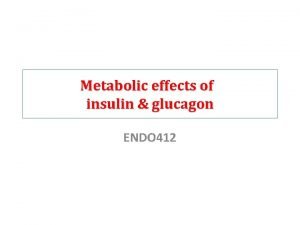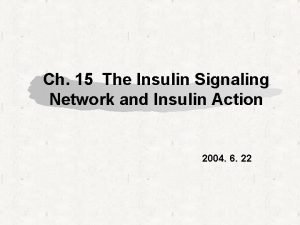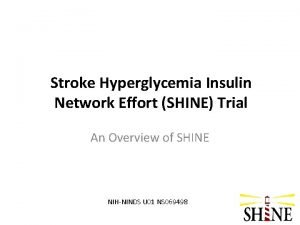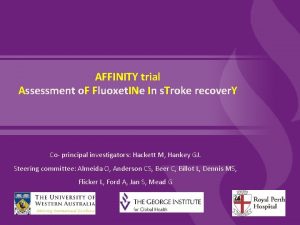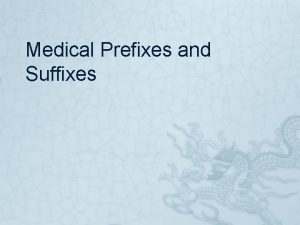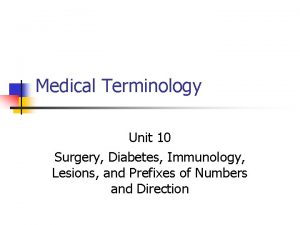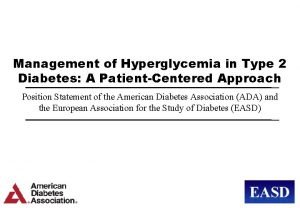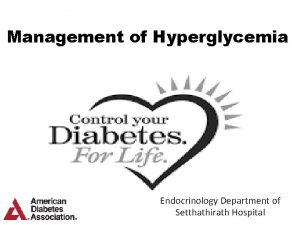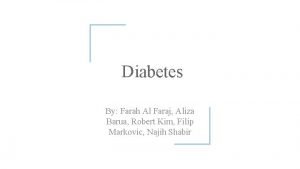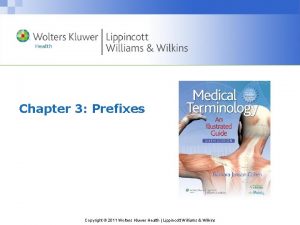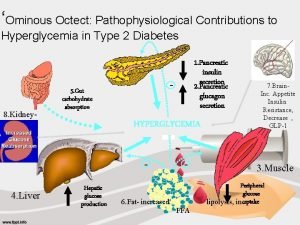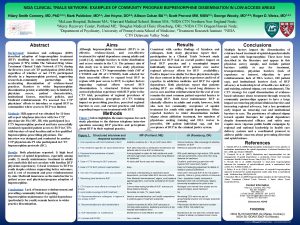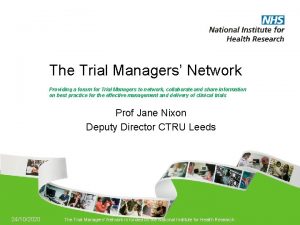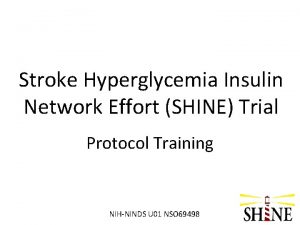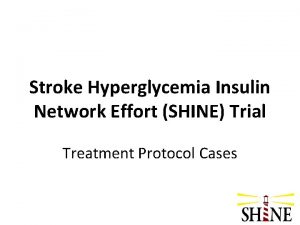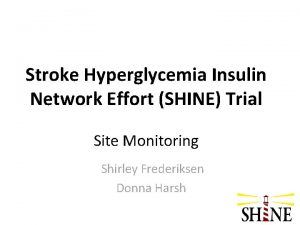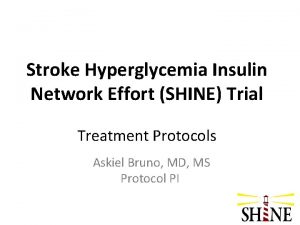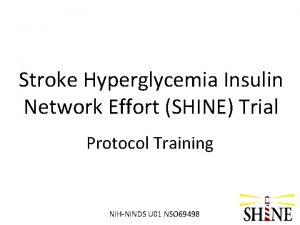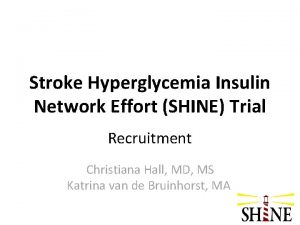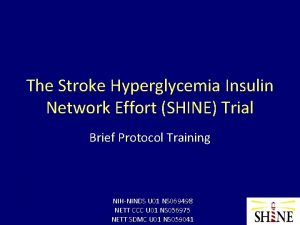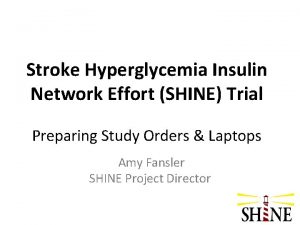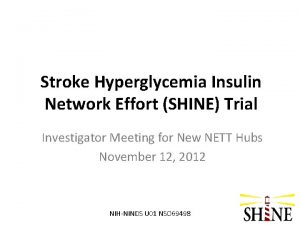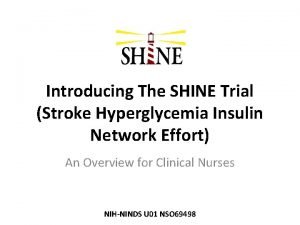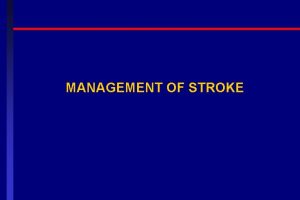Stroke Hyperglycemia Insulin Network Effort SHINE Trial Adverse



















- Slides: 19

Stroke Hyperglycemia Insulin Network Effort (SHINE) Trial Adverse Event Reporting Catherine Dillon

Reporting Adverse Events • Adverse Events (AEs) are “. . . any untoward medical occurrence in a subject that was not previously identified which does not necessarily have a causal relationship to the study drug…” • Events existing prior to randomization should not be reported as AEs, unless there is a change in severity • Pre-existing conditions that are discovered after randomization are not adverse events. These should be documented as medical history. • Abnormal lab values that are considered to be clinical significant by the site investigator are adverse events

Reporting Adverse Events • Adverse Events are reported on Form 06: Adverse Event • Report the diagnosis, not the symptoms: Fever, cough, chest pain, crackles = pneumonia • Death, surgery, intubation, etc. are not adverse events. They are outcomes of adverse events

Reporting Adverse Events • All AEs will be centrally coded verbatim using Med. DRA • 1 AE per CRF • Avoid abbreviations/colloquialisms • AEs that can’t be coded will be queried

Reporting Adverse Events • All AEs must be reported through completion of study treatment • All SAEs must be reported through End of Study

Serious Adverse Events • fatal • life-threatening • result in hospitalization/prolongation of hospitalization • result in disability/congenital anomaly OR • require intervention to prevent permanent impairment or damage

Severity • Refer to NCI Common Terminology Criteria for Adverse Events • CTCAE Categories include: o o o Mild Moderate Severe Life-threatening Disabling • Severity is different from serious: o Severe headache can be non-serious o Mild stroke can be serious

Relatedness to treatment Unrelated · The temporal relationship between treatment exposure and the adverse event is unreasonable or incompatible and/or adverse event is clearly due to extraneous causes (e. g. , underlying disease, environment) Unlikely (must have 2) · May have reasonable or only tenuous temporal relationship to intervention. · Could readily have been produced by the subject’s clinical state, or environmental or other interventions. · Does not follow known pattern of response to intervention. · Does not reappear or worsen with reintroduction of intervention.

Relatedness to treatment Possible (must have 2) · Has a reasonable temporal relationship to intervention. · Could not readily have been produced by the subject’s clinical state or environmental or other interventions. · Follows a known pattern of response to intervention. Probable (must have 3) · Has a reasonable temporal relationship to intervention. · Could not readily have been produced by the subject’s clinical state or have been due to environmental or other interventions. · Follows a known pattern of response to intervention. · Disappears or decreases with reduction in dose or cessation of intervention.

Relatedness to treatment Definite (must have all 4) · Has a reasonable temporal relationship to intervention. · Could not readily have been produced by the subject’s clinical state or have been due to environmental or other interventions. · Follows a known pattern of response to intervention. · Disappears or decreases with reduction in dose or cessation of intervention and recurs with re-exposure.

Data Entry Time Lines for AEs • Non-serious AEs must be submitted into Web. DCUTM within 5 days of data collection • SAEs must be submitted into Web. DCUTM within 24 hours of discovery

Reporting SAEs require additional information: • Detailed description of the event • Relevant tests/laboratory data • Relevant history and pre-existing conditions • Concomitant meds

Reporting SAEs • These narratives assist the Independent Medical Safety Monitor in reviewing the event • Do not identify any subject, physician, or institution by name

Reporting SAEs • Site data enters and submits AE CRF into Web. DCUTM • Automatic e-mail notification to Site Manager (Ms. Arthi RAMAKRISHNAN) • SM reviews narrative - If CRF is sufficient, an automatic email notification will be sent to the Internal Quality and Safety Reviewer (Dr. Cemal SOZENER)

Reporting SAEs • IQSR reviews narrative - If AE data is sufficient, an automatic email notification will be sent to the Independent Medical Safety Monitor (Dr. Tom Bleck) • IMSM reviews the event and indicates whether the event is serious and unexpected • Site Manager closes review process

SAE Reporting • DSMB requires expedited reporting of all SAEs • Site PIs are responsible for reporting the SAE to their IRB according to local requirements • Site PIs responsible for submitting follow-up information into Web. DCUTM , as it becomes available.

Additional Reporting for Neurological Worsening • Neurological worsening associated with glucose concentrations of <=55 mg/d. L and lasting longer than 24 hours must be coded as serious. • Events of sudden neurological worsening ( ≥ 4 point NIHSS score increase) require the completion of Form 22: Neurological Worsening.

Additional Reporting for Hypoglycemia • Blood glucose <40 mg/d. L – Must be coded as severe, life threatening/disabling, or fatal. – Must be coded as serious • Hypoglycemic events defined as blood glucose <70 mg/dl require the completion of Form 17: Hypoglycemic Event Form. • Contact Dr. Bleck (SHINE Hotline) if a subject has 3 or more episodes of hypoglycemia within a 24 hour period. IMSM will determine if the level of sliding scale insulin should be adjusted or if insulin drip protocol should discontinued

Questions?
 Shine jesus shine chords
Shine jesus shine chords Shine jesus shine fill this land with the father's glory
Shine jesus shine fill this land with the father's glory Insulin hormone
Insulin hormone Insulin and insulin receptor
Insulin and insulin receptor Shine trial
Shine trial Anterior stroke vs posterior stroke
Anterior stroke vs posterior stroke Fluoxet
Fluoxet Beta agonist hyperglycemia
Beta agonist hyperglycemia Supragastric prefix
Supragastric prefix Hyperglycemia prefix
Hyperglycemia prefix Gluc/o medical term
Gluc/o medical term Management of hyperglycemia
Management of hyperglycemia Abdapted
Abdapted Asymptomatic hyperglycemia
Asymptomatic hyperglycemia Signs and symptoms of hyperglycemia
Signs and symptoms of hyperglycemia Leuk prefix
Leuk prefix Incretin hormone
Incretin hormone Nida clinical trial network
Nida clinical trial network Trial managers network
Trial managers network Adverse reaction definition
Adverse reaction definition


